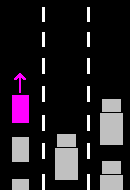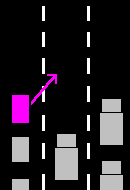Are you breaking the law?
By Richard Whitehand, October 2002
Many people realise that the lack of a user-centred approach to development, combined with the absence of usability testing, will often result in unforeseen problems in the design of products and systems. Unfortunately this can even be the case in the development of public legislation.
A few years ago a change to the Swedish road traffic regulations meant that since then the vast majority of drivers in Stockholm have been regularly breaking the law without knowing it. Are you one of them?
Imagine this scenario
You are driving through central Stockholm on the main motorway (E4). The speed limit is 70km/h (and you're keeping to it). You move into the outside lane of the motorway in order to overtake some slower vehicles.
So far, you have not broken the law. You have now passed the slower vehicles and there is no more traffic directly in front of you. There are several cars immediately behind, wanting to drive faster than you.
What should you do now?
 A Continue in the outside lane. |
 B Change to an inner lane to allow cars behind to overtake |
Most people would select "B" - would you? Unfortunately this choice would result in you breaking the law (currently a 600 SEK fine, if you're caught).
Perhaps you are now wondering why this is the case. Well, the law states that on a multi-carriageway road with a speed limit of 70km/h or less then you're NOT ALLOWED to change out of the lane you are in, UNLESS:
- You are going to overtake.
- You intend to turn off at a junction.
- You are going to stop or park your vehicle.
Unfortunately you must stay in the lane you are in, as:
(1) does not apply - you have already overtaken.
(2) does not apply - you are driving all the way through Stockholm.
(3) does not apply - you are not going to stop or park on the motorway.
Still not convinced? The road traffic regulations can be found (in Swedish) at: http://www.notisum.se/rnp/sls/lag/19981276.htm (Hint: Chapter 3, sections 7 & 9).
How did the law get formulated in this way? Why do most drivers unwittingly break it? Discussions with the Swedish National Road Administration (Vägverket) reveal that they see no problem. However, one wonders how the regulations ended up this way. One can imagine that several factors may have come into play (see below), however, they all boil down to a single overall problem - the
- Poor understanding of the real usage situation. The road traffic administration (Vägverket) is based in Borlänge, some distance from Stockholm. One can suppose that its staff mainly live and drive there, rather than in the Stockholm area, where long sections of 70km/h multi-lane carriageways are common. Perhaps they imagine Stockholm as a permanent traffic jam and thus lane changes should always be avoided? (Infact traffic is bad, but only at rush hours, and this law applies all the time).
- Lack of user testing of proposed changes The proposed regulation changes would have benefited from being tested with a representative selection of real drivers in real driving situations (or simulations) before being made law.
- Poor information to users upon 'implementation' This particular regulation came into force late in 1998. An information leaflet was sent out at the time. Unfortunately it is unlikely that all drivers saw it, and even if they did, the implications of this particular aspect of the change in the law weren't immediately apparent in the leaflet.
- "There isn't a problem" in response to user concern. Probably the biggest (and easiest) mistake to make. Its quite natural that the people who developed the regulations understand them, and have some reasoning behind them. Unfortunately what matters is whether the users of the regulations have the same understanding.
Finally, incase you had any doubts, then driving through Stockholm and strictly following this law can be a rather unnerving experience. Car drivers behind will tend to get somewhat upset if you insist in staying in the outside lane at 70km/h(!)
Did you find this editorial interesting?
You might like to read some of our other editorials.
Please send us an email if you have any comments or suggestions!